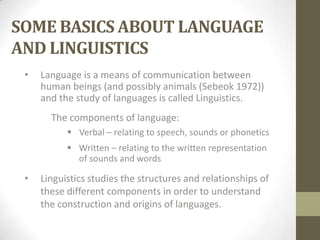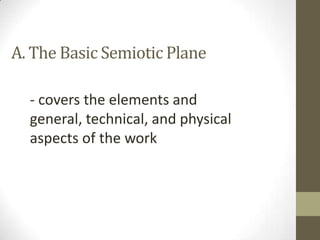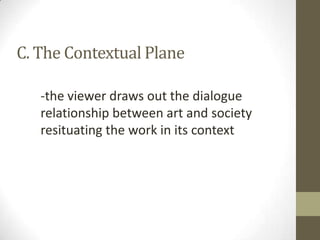Semiotics
- 1. SEMIOTICS
- 2. SOME BASICS ABOUT LANGUAGE AND LINGUISTICS ŌĆó Language is a means of communication between human beings (and possibly animals (Sebeok 1972)) and the study of languages is called Linguistics. The components of language: ’é¦ Verbal ŌĆō relating to speech, sounds or phonetics ’é¦ Written ŌĆō relating to the written representation of sounds and words ŌĆó Linguistics studies the structures and relationships of these different components in order to understand the construction and origins of languages.
- 3. ŌĆ£Semiotics is concerned with everything that can be taken as a sign. ŌĆ£ Umberto Eco
- 4. ŌĆó Semiotics is the study of signs and signification.
- 5. ŌĆó Developed from studies of language and logic ’é¦ Ferdinand de Saussure (Switzerland) ’é¦ Charles Sanders Pierce (America)
- 6. Sausurre ŌĆó Explored signs in relation to language ŌĆó Construction of signs and their meaning rather than the structures of specific languages ’ü▒ Signifier ŌĆō the physical element, the actual spoken or written word ’ü▒ Signified ŌĆō the mental concept, the idea of the sign ’é¦ Assigned by time, convention and practice ’é¦ Relational and depends on its difference from other words
- 7. ŌĆó Semiology ’é¦ langue ŌĆō the system of signifier/signified, or linguistic signs ’é¦ parole ŌĆō the practical application of the system within a specific language, or act of speech
- 8. Pierce ŌĆó Explored the sign within the broader context of: ’é¦ Ontology ŌĆō study of pure being and the essence of things ’é¦ Phenomenology ŌĆō study of experiencing phenomena in the world
- 9. Three Elements to the Sign ŌĆó Representamen ŌĆō the sign itself (i.e. a word) ŌĆó Object ŌĆō to which the representamen refers to ŌĆó Interpretant ŌĆō the sense of the thing which links the other two
- 10. Semiosis ŌĆō the interaction of those three components; the interptetant can be a representamen to another sign leading to another sign leading to a potentially infinite cycle.
- 11. ŌĆó Identified different states or stages of the object and interpretent ’é¦ Symbolic, iconic, and indexical ŌĆō can be understood on a scale of arbitrariness or conventionality ŌĆó Developed a typology of signs based on the different modes of relationship between the components of the triad
- 12. ŌĆó Symbolic mode ŌĆō arbitrary signs, no intrinsic relationship between the elements of the sign ŌĆó Indexical mode ŌĆō signs in which there is a direct connection or genuine relationship between the representamen/signifier and interpretant/signified ŌĆó Iconic mode ŌĆō signs which owe their connection to the object through some resemblance between representamen/signifier and interpretant/signified
- 13. An Allegory with Venus and Cupid, Bronzino.
- 14. ŌĆ£ŌĆ”a nude Venus with Cupid kissing her, and on one side Pleasure and Play with other Loves; and on the other, Fraud, Jealousy, and other passions of love. Venus and Cupid are identifiable by their attributes, as is the old man with wings and an hourglass who must be Time (not mentioned by Vasari). The identity of the other figures, and the meaning of the picture remain uncertain. The howling figure on the left has been variously interpreted as Jealousy, Despair and the effects of syphilis; the boy scattering roses and stepping on a thorn as Jest, Folly and Pleasure; the hybrid creature with the face of a girl, as Pleasure and Fraud; and the figure in the top left corner as Fraud and Oblivion.ŌĆØ http://www.nationalgallery.org.uk/paintings/bronzino-an-allegory-with-venus-and-cupid
- 16. A. The Basic Semiotic Plane - covers the elements and general, technical, and physical aspects of the work
- 17. B. The Iconic Plane or the Image Itself - includes the choice of the subject which may bear social and political implications
- 18. C. The Contextual Plane -the viewer draws out the dialogue relationship between art and society resituating the work in its context


















